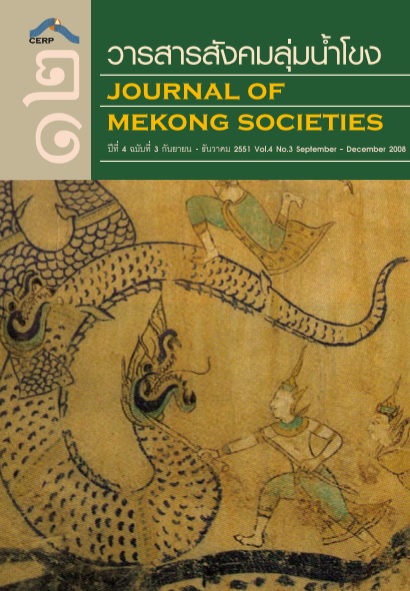Khon Kaen Pillar: The Constructions and Contested meaning in Power Space
Main Article Content
Abstract
A study of the social history of Khon Kaen city indicates that the Lak muang or city pillar is a social space where local people, the state, and the capital have continuously constructed and negotiated their power. These processes can be divided into several chronological periods. The late 1780s (the decade of 2330 BE.) constituted the period of the city’s settlement; the Lak Ban (or Bue Ban) was established as the center of the community. During the following decade of the late 1790’s (2340 BE), central government power penetrated the locality in order to control it and extract benefits. The city governor (chao muang) was someone appointed by the central government rathr than alocal person who sent tribute as in the past. After the city was relocated, a new pillar was set up, which became a symbol of central government power rather than the center of the local community. A key political change in Khon Kaen city took place during the regime of King Rama V, the era of political revolution. In 1893 (2436 BE), the city governor system was abolished and replaced by that of governor (kha luang pracham muang). Under this new system which was resisted by the Holy Man’s Rebellion in Hua Muang Lao, the power of the pillar, which had symbolized the city governor’s power, decreased. At the same time the power of the city governor was also diminished. When the pillar was moved to the Chinese business district along the railway in 1942 (2485 BE) and the formal opening ceremony was organized in 1955 (2598 BE), it became an area where local entrepreneurs, including both business men and local politicians conducted their rituals. Consequently, the rituals related to the pillar have been increasingly combined with Chinese customs. This change links the Sino-Thai to state power and the capital. In the context of promoting the city’s identity, starting in the mid-2000s (the decade of 2550 BE), later generations of Chinese descendants have been involved in administering Khon Kaen Municipality. The rituals, which integrate syncretic beliefs along with paying homage to the king, became sacred. In addition, the pillar was transformed turned into a political space linking business among the Chinese groups. This space has also served as a center in which the city residents participate in development according to municipal development plans. There are various conditions allowing these groups to make use of the pillar in exercising their power. These conditions include changes in cental state and local capital power, as well as the influence of global ideas on politics and development. These changes utilize symbolic capitals including rituals and beliefs as a condition to create and maintain economic and political capitals.

